【已解决】C#中获得当前任务栏的大小(宽度和高度)和位置(X,Y) 和 当前屏幕的右下角位置(X,Y) – 均支持任务栏的下右上左四种模式
在折腾:
的过程中,需要知道任务栏的高度和位置,才能准确将子窗体显示在右下角。
【解决过程】
1.参考:
How do I get the taskbar’s position and size?
去写了代码:
|
1 |
Rectangle taskbarRect = Screen.PrimaryScreen.WorkingArea; |
然后调试的结果是:
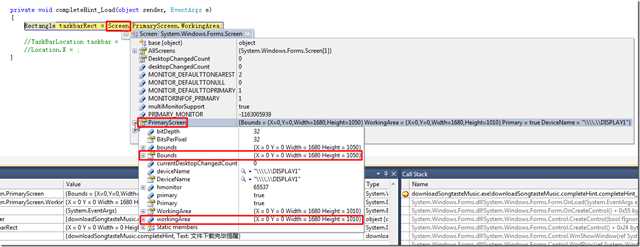
而对应的屏幕分辨率是1680×1050:
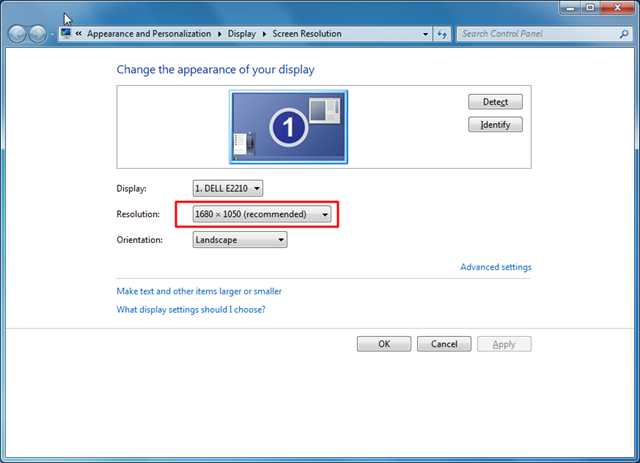
对应的当前任务栏是在屏幕下面的:

2.又去测试了其他几种情况:
任务栏是在右边的:
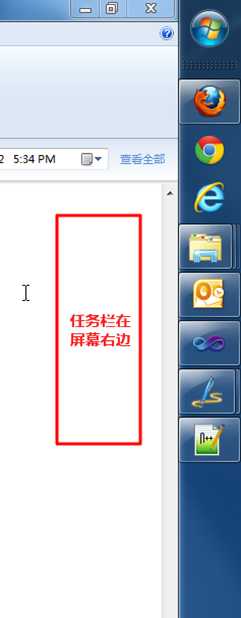
然后调试结果是:
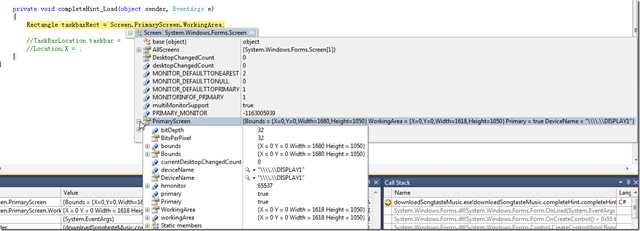
任务栏在上面的:
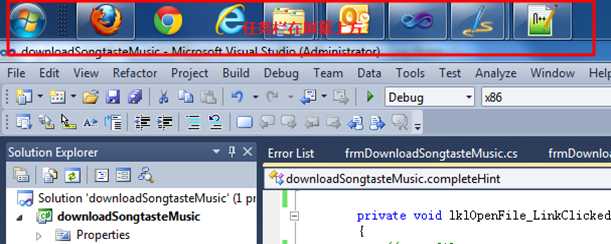

任务栏在左边的:
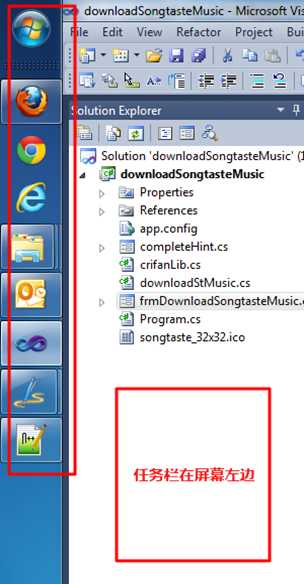
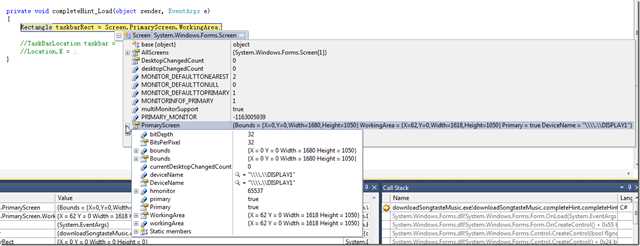
3.由此,继续去调试,期间遇到想要设置窗口位置的问题,后来解决了,详参:
【已解决】C#中通过代码改变/设置窗口的位置(Location)
4.最终整理出算法,始终希望窗口位置显示在屏幕边角,贴近任务栏中是显示时间的那个位置:
|
1 2 3 4 5 6 7 8 9 10 11 12 13 14 15 16 17 18 19 20 21 22 23 24 25 26 27 28 29 30 31 32 33 34 35 36 37 38 39 40 41 |
// get current right bottom corner position(X, Y), support four mode: taskbar bottom/right/up/left public Point getCornerLocation() { int xPos = 0, yPos = 0;
if( (Screen.PrimaryScreen.Bounds.Width == Screen.PrimaryScreen.WorkingArea.Width) && (Screen.PrimaryScreen.WorkingArea.Y == 0)) { //taskbar bottom xPos = Screen.PrimaryScreen.WorkingArea.Width - this.Size.Width; yPos = Screen.PrimaryScreen.WorkingArea.Height - this.Size.Height; } else if((Screen.PrimaryScreen.Bounds.Height == Screen.PrimaryScreen.WorkingArea.Height) && (Screen.PrimaryScreen.WorkingArea.X == 0) ) { //taskbar right xPos = Screen.PrimaryScreen.WorkingArea.Width - this.Size.Width; yPos = Screen.PrimaryScreen.WorkingArea.Height - this.Size.Height; } else if((Screen.PrimaryScreen.Bounds.Width == Screen.PrimaryScreen.WorkingArea.Width) && (Screen.PrimaryScreen.WorkingArea.Y > 0) ) { //taskbar up xPos = Screen.PrimaryScreen.WorkingArea.Width - this.Size.Width; yPos = Screen.PrimaryScreen.WorkingArea.Y; } else if ((Screen.PrimaryScreen.Bounds.Height == Screen.PrimaryScreen.WorkingArea.Height) && (Screen.PrimaryScreen.WorkingArea.X > 0)) { //taskbar left xPos = Screen.PrimaryScreen.WorkingArea.X; yPos = Screen.PrimaryScreen.WorkingArea.Height - this.Size.Height; }
return new Point(xPos, yPos); }
private void completeHint_Load(object sender, EventArgs e) { this.Location = getCornerLocation(); } |
5.然后,又花时间,整理出来函数,可以获得当前屏幕的任务栏的大小:
|
1 2 3 4 5 6 7 8 9 10 11 12 13 14 15 16 17 18 19 20 21 22 23 24 25 26 27 28 29 30 31 32 33 34 35 36 37 38 39 40 41 42 |
// get current taskbar size(width, height), support four mode: taskbar bottom/right/up/left public Size getCurTaskbarSize() { int width = 0, height = 0;
if ((Screen.PrimaryScreen.Bounds.Width == Screen.PrimaryScreen.WorkingArea.Width) && (Screen.PrimaryScreen.WorkingArea.Y == 0)) { //taskbar bottom width = Screen.PrimaryScreen.WorkingArea.Width; height = Screen.PrimaryScreen.Bounds.Height - Screen.PrimaryScreen.WorkingArea.Height; } else if ((Screen.PrimaryScreen.Bounds.Height == Screen.PrimaryScreen.WorkingArea.Height) && (Screen.PrimaryScreen.WorkingArea.X == 0)) { //taskbar right width = Screen.PrimaryScreen.Bounds.Width - Screen.PrimaryScreen.WorkingArea.Width; height = Screen.PrimaryScreen.WorkingArea.Height; } else if ((Screen.PrimaryScreen.Bounds.Width == Screen.PrimaryScreen.WorkingArea.Width) && (Screen.PrimaryScreen.WorkingArea.Y > 0)) { //taskbar up width = Screen.PrimaryScreen.WorkingArea.Width; //height = Screen.PrimaryScreen.WorkingArea.Y; height = Screen.PrimaryScreen.Bounds.Height - Screen.PrimaryScreen.WorkingArea.Height; } else if ((Screen.PrimaryScreen.Bounds.Height == Screen.PrimaryScreen.WorkingArea.Height) && (Screen.PrimaryScreen.WorkingArea.X > 0)) { //taskbar left width = Screen.PrimaryScreen.Bounds.Width - Screen.PrimaryScreen.WorkingArea.Width; height = Screen.PrimaryScreen.WorkingArea.Height; }
return new Size(width, height); }
private void completeHint_Load(object sender, EventArgs e) { Size curTaskbarSize = getCurTaskbarSize(); } |
【总结】
凡事,还是要靠自己,靠别人还是不靠谱。
C#中,获得当前任务栏的大小,以及获得当前屏幕的边角(靠近任务栏中时间的那个)位置的相关代码如下:
|
1 2 3 4 5 6 7 8 9 10 11 12 13 14 15 16 17 18 19 20 21 22 23 24 25 26 27 28 29 30 31 32 33 34 35 36 37 38 39 40 41 42 43 44 45 46 47 48 49 50 51 52 53 54 55 56 57 58 59 60 61 62 63 64 65 66 67 68 69 70 71 72 73 74 75 76 77 78 79 80 81 |
// get current taskbar size(width, height), support four mode: taskbar bottom/right/up/left public Size getCurTaskbarSize() { int width = 0, height = 0;
if ((Screen.PrimaryScreen.Bounds.Width == Screen.PrimaryScreen.WorkingArea.Width) && (Screen.PrimaryScreen.WorkingArea.Y == 0)) { //taskbar bottom width = Screen.PrimaryScreen.WorkingArea.Width; height = Screen.PrimaryScreen.Bounds.Height - Screen.PrimaryScreen.WorkingArea.Height; } else if ((Screen.PrimaryScreen.Bounds.Height == Screen.PrimaryScreen.WorkingArea.Height) && (Screen.PrimaryScreen.WorkingArea.X == 0)) { //taskbar right width = Screen.PrimaryScreen.Bounds.Width - Screen.PrimaryScreen.WorkingArea.Width; height = Screen.PrimaryScreen.WorkingArea.Height; } else if ((Screen.PrimaryScreen.Bounds.Width == Screen.PrimaryScreen.WorkingArea.Width) && (Screen.PrimaryScreen.WorkingArea.Y > 0)) { //taskbar up width = Screen.PrimaryScreen.WorkingArea.Width; //height = Screen.PrimaryScreen.WorkingArea.Y; height = Screen.PrimaryScreen.Bounds.Height - Screen.PrimaryScreen.WorkingArea.Height; } else if ((Screen.PrimaryScreen.Bounds.Height == Screen.PrimaryScreen.WorkingArea.Height) && (Screen.PrimaryScreen.WorkingArea.X > 0)) { //taskbar left width = Screen.PrimaryScreen.Bounds.Width - Screen.PrimaryScreen.WorkingArea.Width; height = Screen.PrimaryScreen.WorkingArea.Height; }
return new Size(width, height); }
// get current right bottom corner position(X, Y), support four mode: taskbar bottom/right/up/left public Point getCornerLocation() { int xPos = 0, yPos = 0;
if( (Screen.PrimaryScreen.Bounds.Width == Screen.PrimaryScreen.WorkingArea.Width) && (Screen.PrimaryScreen.WorkingArea.Y == 0)) { //taskbar bottom xPos = Screen.PrimaryScreen.WorkingArea.Width - this.Size.Width; yPos = Screen.PrimaryScreen.WorkingArea.Height - this.Size.Height; } else if((Screen.PrimaryScreen.Bounds.Height == Screen.PrimaryScreen.WorkingArea.Height) && (Screen.PrimaryScreen.WorkingArea.X == 0) ) { //taskbar right xPos = Screen.PrimaryScreen.WorkingArea.Width - this.Size.Width; yPos = Screen.PrimaryScreen.WorkingArea.Height - this.Size.Height; } else if((Screen.PrimaryScreen.Bounds.Width == Screen.PrimaryScreen.WorkingArea.Width) && (Screen.PrimaryScreen.WorkingArea.Y > 0) ) { //taskbar up xPos = Screen.PrimaryScreen.WorkingArea.Width - this.Size.Width; yPos = Screen.PrimaryScreen.WorkingArea.Y; } else if ((Screen.PrimaryScreen.Bounds.Height == Screen.PrimaryScreen.WorkingArea.Height) && (Screen.PrimaryScreen.WorkingArea.X > 0)) { //taskbar left xPos = Screen.PrimaryScreen.WorkingArea.X; yPos = Screen.PrimaryScreen.WorkingArea.Height - this.Size.Height; }
return new Point(xPos, yPos); }
private void completeHint_Load(object sender, EventArgs e) { Size curTaskbarSize = getCurTaskbarSize();
this.Location = getCornerLocation(); } |
【后记 2012-09-25】
后来,又添加了,获得当前任务栏的位置的函数。
全部的代码如下:
|
1 2 3 4 5 6 7 8 9 10 11 12 13 14 15 16 17 18 19 20 21 22 23 24 25 26 27 28 29 30 31 32 33 34 35 36 37 38 39 40 41 42 43 44 45 46 47 48 49 50 51 52 53 54 55 56 57 58 59 60 61 62 63 64 65 66 67 68 69 70 71 72 73 74 75 76 77 78 79 80 81 82 83 84 85 86 87 88 89 90 91 92 93 94 95 96 97 98 99 100 101 102 103 104 105 106 107 108 109 110 111 112 113 114 115 116 117 118 |
using System.Drawing; using System.Windows.Forms;
/*********************************************************************/ /* Screen */ /*********************************************************************/
// get current taskbar size(width, height), support 4 mode: taskbar bottom/right/up/left public Size getCurTaskbarSize() { int width = 0, height = 0;
if ((Screen.PrimaryScreen.Bounds.Width == Screen.PrimaryScreen.WorkingArea.Width) && (Screen.PrimaryScreen.WorkingArea.Y == 0)) { //taskbar bottom width = Screen.PrimaryScreen.WorkingArea.Width; height = Screen.PrimaryScreen.Bounds.Height - Screen.PrimaryScreen.WorkingArea.Height; } else if ((Screen.PrimaryScreen.Bounds.Height == Screen.PrimaryScreen.WorkingArea.Height) && (Screen.PrimaryScreen.WorkingArea.X == 0)) { //taskbar right width = Screen.PrimaryScreen.Bounds.Width - Screen.PrimaryScreen.WorkingArea.Width; height = Screen.PrimaryScreen.WorkingArea.Height; } else if ((Screen.PrimaryScreen.Bounds.Width == Screen.PrimaryScreen.WorkingArea.Width) && (Screen.PrimaryScreen.WorkingArea.Y > 0)) { //taskbar up width = Screen.PrimaryScreen.WorkingArea.Width; //height = Screen.PrimaryScreen.WorkingArea.Y; height = Screen.PrimaryScreen.Bounds.Height - Screen.PrimaryScreen.WorkingArea.Height; } else if ((Screen.PrimaryScreen.Bounds.Height == Screen.PrimaryScreen.WorkingArea.Height) && (Screen.PrimaryScreen.WorkingArea.X > 0)) { //taskbar left width = Screen.PrimaryScreen.Bounds.Width - Screen.PrimaryScreen.WorkingArea.Width; height = Screen.PrimaryScreen.WorkingArea.Height; }
return new Size(width, height); }
// get current taskbar position(X, Y), support 4 mode: taskbar bottom/right/up/left public Point getCurTaskbarLocation() { int xPos = 0, yPos = 0;
if ((Screen.PrimaryScreen.Bounds.Width == Screen.PrimaryScreen.WorkingArea.Width) && (Screen.PrimaryScreen.WorkingArea.Y == 0)) { //taskbar bottom xPos = 0; yPos = Screen.PrimaryScreen.WorkingArea.Height; } else if ((Screen.PrimaryScreen.Bounds.Height == Screen.PrimaryScreen.WorkingArea.Height) && (Screen.PrimaryScreen.WorkingArea.X == 0)) { //taskbar right xPos = Screen.PrimaryScreen.WorkingArea.Width; yPos = 0; } else if ((Screen.PrimaryScreen.Bounds.Width == Screen.PrimaryScreen.WorkingArea.Width) && (Screen.PrimaryScreen.WorkingArea.Y > 0)) { //taskbar up xPos = 0; yPos = 0; } else if ((Screen.PrimaryScreen.Bounds.Height == Screen.PrimaryScreen.WorkingArea.Height) && (Screen.PrimaryScreen.WorkingArea.X > 0)) { //taskbar left xPos = 0; yPos = 0; }
return new Point(xPos, yPos); }
// get current right bottom corner position(X, Y), support 4 mode: taskbar bottom/right/up/left public Point getCornerLocation(Size windowSize) { int xPos = 0, yPos = 0;
if ((Screen.PrimaryScreen.Bounds.Width == Screen.PrimaryScreen.WorkingArea.Width) && (Screen.PrimaryScreen.WorkingArea.Y == 0)) { //taskbar bottom xPos = Screen.PrimaryScreen.WorkingArea.Width - windowSize.Width; yPos = Screen.PrimaryScreen.WorkingArea.Height - windowSize.Height; } else if ((Screen.PrimaryScreen.Bounds.Height == Screen.PrimaryScreen.WorkingArea.Height) && (Screen.PrimaryScreen.WorkingArea.X == 0)) { //taskbar right xPos = Screen.PrimaryScreen.WorkingArea.Width - windowSize.Width; yPos = Screen.PrimaryScreen.WorkingArea.Height - windowSize.Height; } else if ((Screen.PrimaryScreen.Bounds.Width == Screen.PrimaryScreen.WorkingArea.Width) && (Screen.PrimaryScreen.WorkingArea.Y > 0)) { //taskbar up xPos = Screen.PrimaryScreen.WorkingArea.Width - windowSize.Width; yPos = Screen.PrimaryScreen.WorkingArea.Y; } else if ((Screen.PrimaryScreen.Bounds.Height == Screen.PrimaryScreen.WorkingArea.Height) && (Screen.PrimaryScreen.WorkingArea.X > 0)) { //taskbar left xPos = Screen.PrimaryScreen.WorkingArea.X; yPos = Screen.PrimaryScreen.WorkingArea.Height - windowSize.Height; }
return new Point(xPos, yPos); } |
函数使用举例:
|
1 2 3 4 5 6 |
private void completeHint_Load(object sender, EventArgs e) { Size curTaskbarSize = crl.getCurTaskbarSize(); Point curTaskbarLocation = crl.getCurTaskbarLocation(); this.Location = crl.getCornerLocation(this.Size); } |
另,上述所有函数,都已整理至:
转载请注明:在路上 ? 【已解决】C#中获得当前任务栏的大小(宽度和高度)和位置(X,Y) 和 当前屏幕的右下角位置(X,Y) – 均支持任务栏的下右上左四种模式
来自 <https://www.crifan.com/csharp_get_current_taskbar_location_and_height/>
